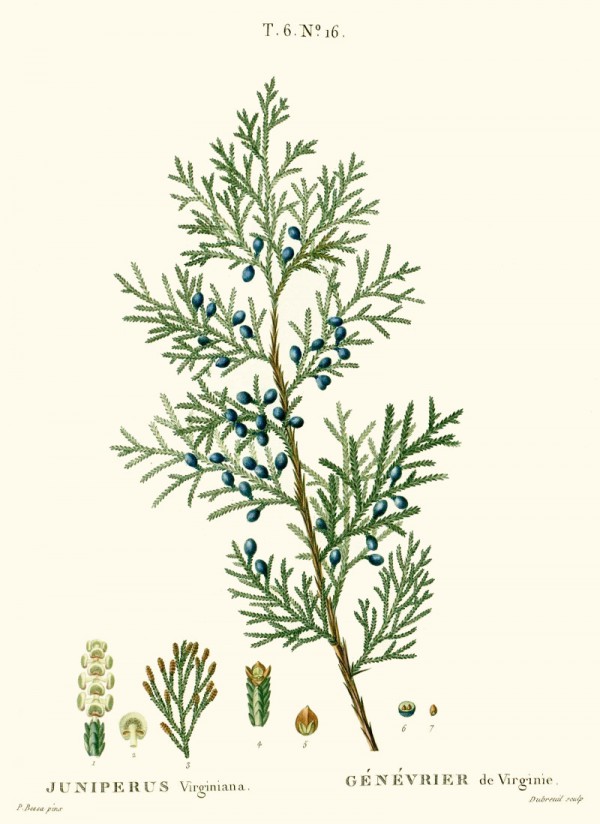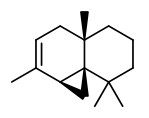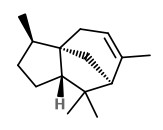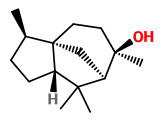Juniperus virginiana L. - Cupressaceae - eastern redcedar, pencil cedar, Virginischer Wacholder, Bleistiftzeder
Dioecious tree, up to 30 m high, native to eastern North America, cultivated in Europe; bark brown, exfoliating in thin stripes; whip leaves 3-6 mm, scalelike leaves 1-3 mm, overlapping; seed cones globose to ovoid, 3-6 mm, blue-black to brownish blue when mature.
http://www.efloras.org/florataxon.aspx?flora_id=1&taxon_id=210000931
„The fine-grained, soft brittle pinkish- to brownish-red heartwood is fragrant, very light and very durable, even in contact with soil. Because of its rot resistance, the wood is used for fence posts. The aromatic wood is avoided by moths, so it is in demand as lining for clothes chests and closets, often referred to as cedar closets and cedar chests…
The wood is marketed as „eastern redcedar“ or „aromatic cedar“. The best portions of the heartwood are one of the few woods good for making pencils, but the supply had diminished sufficiently by the 1940s that it was largely replaced by California incense cedar.“
http://en.wikipedia.org/wiki/Juniperus_virginiana
Red cedarwood oil possesses a soft, pleasant, balsamic typical cedarwood odor. Fractionation and analysis of Virginia cedarwood oil made clear that hydrocarbons (thujopsene, cedrene) and cedrol (week woody odor) hardly contribute to the specific odor of the oil. Fractions with woody, amber, phenolic, lactonic, and grapefruit aspects were found. Oxygenated sesquiterpenes like betulenal (with odor aspects of sandalwood and acetylcedrene), funebrenal (8-cedren-15-al or α-cedrenal, woody), thujopsenal, chamigrenal, 8-cedren-10-one (musty, woody, mint, myrrh-like), and nootkatone (grapefruit-like) seem to contribute to the typical cedarwood character of the oil.
[„On the chemical composition of cedarwood oil (Juniperus virginiana L.).“, Heide, R. T., Visser, J., Van der Linde, L. M., Van Lier, F. P., Developments in food science, 18, (1988), 627-637]
The volatile oil of J.virginiana wood contained widdrene (thujopsene, 21%), α-cedrene (21%), β-cedrene (8%), α-cedrol (22%), widdrol (2%), cuparene (1%), and α-bisabolol (0.6%).
[Adams, R. P. „Cedar wood oil-Analyses and properties.“ Essential oils and waxes. Springer Berlin Heidelberg, 1991, 159-173] http://www.juniperus.org/uploads/2/2/6/3/22639912/99-1991sprverlag159-173.pdf
Cedarwood oil yields (fresh weight) were 2.3% (liquid CO2) and 5.9% (EtOH). „The data demonstrate that extracts from J. virginiana, especially CWO, can impart significant resistance to both termites as well as
wood-rot fungi. Cedarwood oil is Generally Regarded As Safe …
Small trees have relatively low amounts of CWO because small trees have high percentages of sapwood which contains very low amounts of CWO compared to the heartwood“
[Critical fluid extraction of Juniperus virginiana L. and bioactivity of extracts against subterranean termites and wood-rot fungi. Eller, F. J., Clausen, C. A., Green, F., & Taylor, S. L., Industrial crops and products, Vol.32(3), 2010, 481-485]
„α-Cedrene and thujopsene are the main products of the sesquiterpene fraction of red cedarwood oil (Juniperus virginiana L., Cupressaceae). While these sesquiterpenes possess only weak and uncharacteristic odors, some oxygenated derivatives are widely used in perfumery. The most important volume is the acetylation product of the sequiterpene fraction, sold under trade names such as Vertofix Coeur (IFF), Lignofix (Symrise), and Cedartone V (Givaudan). It possesses an intense woody, ambery odor, which is attributed to a content of 5-10% of [1-aceto-7,10-ethano-4,4,7-trimethyl-1(9)-octalin, CAS 32388-56-0] …
α-Acetylcedrene (methyl cedryl ketone, MCK), formed under the same conditions, also exihibits a warm woody smell, whereas β-acetylcedrene has only a very weak odor.“
[Scent and Chemistry, Günther Ohloff, Wilhelm Pickenhagen, Philip Kraft, Wiley-VCH, 2012, 172-175] see also
[Acid-catalyzed isomerization of thujopsene., Kitchens, G. C., Daeniker, H. U., Hochstetler, A. R., Kaiser, K., The Journal of Organic Chemistry, Vol.37(1), 1972, 1-5]
[Acetylation of thujopsene., Kitchens, G.C., Daeniker, H.U., Hochstetler, A.R., Kaiser, K., Blount, J. F., The Journal of Organic Chemistry, 37(1), 1972, 6-8]
„As cedarwood oil (Juniperus virginiana L.) is a by-product of the American timber industry, it is one of the most economical and abundant sources of sesquiterpenes. This makes it an attractive starting material for the synthesis of other odorants like Vertofix®. On the other hand, any attempt to introduce a new cedarwood odorant is a lost cause, simply because cedarwood oil is so inexpensive. (+)-Cedrol (155) is responsible for its soft, woody odour, typical of cedarwood, and it is isolated from the oil by fractional distillation followed by crystallization.“
[Fráter, Georg, Jerzy A. Bajgrowicz, and Philip Kraft. „Fragrance chemistry.“ Tetrahedron 54.27 (1998): 7633-7703]

Duhamel du Monceau, H.L., Traité des arbres et arbustes, Nouvelle édition [Nouveau Duhamel], vol.6, t.16 (1815) [P.Bessa]
http://plantgenera.org/species.php?id_species=570961
Juniperus virginiana
© Rolf Marschner (2010),
www.botanische-spaziergaenge.at



